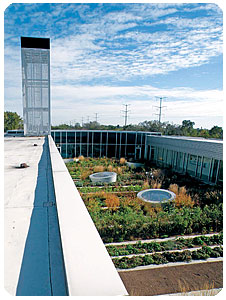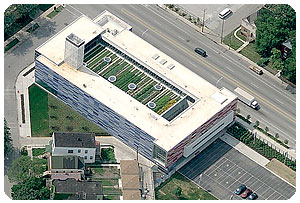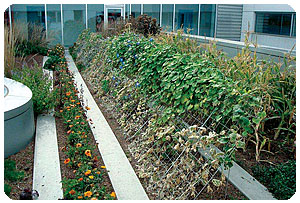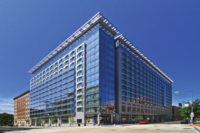
Low-income residents and children plant and maintain a 3,800-square-foot vegetable garden at the Louisville Scholar House. Photo courtesy of American Hydrotech, Inc.
As the demand for locally grown produce increases, urban communities are becoming more and more creative in finding ways to meet that demand. Urban agriculture can be as simple as windowsill herb gardens or as vast and vibrant as large community gardens that encompass entire city blocks. The acres of unused building rooftops in these areas present the perfect environment to contribute substantially to the volume of locally grown produce in urban communities.

Students at the Gary Comer Youth Center cultivate and maintain a rooftop vegetable garden. Photo courtesy of American Hydrotech, Inc.
Gary Comer Youth Center, Chicago
Not only do urban rooftops provide the space, sunlight and fresh air plants need to thrive, but in especially challenged neighborhoods they also provide a safe space for community members to interact with nature. At the Gary Comer Youth Center on Chicago’s south side, students cultivate and maintain an 8,600-square-foot rooftop vegetable garden. The garden is part of a comprehensive “seed-to-table” program where participants (ages 13-18) not only plant and harvest everything from cucumbers to popcorn to potatoes in the 18-24 inches of engineered lightweight soil on the roof, but they also take part in culinary classes where they learn to prepare fresh and nutritious meals with the produce they’ve grown.Under the direction of garden manager Marji Hess, the GCYC rooftop produced more than 1,000 pounds of food last year alone. Whatever produce the students don’t use themselves is sold at a farmers market and to several prominent restaurants all over the city.
“The rooftop garden is both an oasis from urban stress and also a stepping stone to future careers,” says Hess. “The rooftop really shows the sky is the limit when youth and gardening are brought together.”

Garden rooftops provide an opportunity in urban environments to safely interact with nature. Gary Comer Youth Center, photo courtesy of American Hydrotech, Inc.
Scholar House, Louisville
Rooftop vegetable gardens have great potential as educational opportunities. A similar program on a slightly smaller scale exists on the roof of the Scholar House in Louisville, Ky. The Scholar House provides housing for low-income single parents and children while the parents pursue degrees from local colleges and universities. Part of the adjacent child development center is an accessible rooftop where residents and children plant and maintain a 3,800-square-foot vegetable garden.“Our children have eaten many vegetables that they had not even seen before,” said Cathe Dykstra, president and chief executive officer of Family Scholar House, the parent organization of the Louisville Scholar House. “They tried them because they grew them and cooked them with their parent. Our programs are about learning new things to break the cycle of poverty. Nutrition and environmentally friendly living are integral to the future for our families and our community.”

Everything from cucumbers to potatoes to popcorn is planted and harvested as part of the “seed-to-table” program. Gary Comer Youth Center, photo courtesy of American Hydrotech, Inc.
Garden Roof Assembly
Both projects utilize American Hydrotech’s Garden Roof Assembly, which starts with a hot rubberized asphalt waterproofing membrane and includes insulation, drainage/water retention components and soil. The soil is specially engineered for a lighter weight and optimum drainage, which allows it to be installed on a roof where weight can be a concern. This creates a gardening experience almost indistinguishable from one at ground level. Unlike a container garden, this type of built-up assembly allows nutrients and water to be shared across the roof and provides plenty of room both horizontally and vertically for the plants’ roots to spread and grow.Rooftop vegetable gardens allow for the distance from the source of food to the table to be measured in feet instead of miles. This increases the nutritional quality of food and provides new opportunities for an urban population that often has limited access to fresh, high-quality produce. As the local food and urban agriculture movements gain momentum, urban rooftops will become an integral part of the way we feed our cities.

